
There are currently 8 different types of bear species in the world. We use the word ‘currently’ for the sad reason that some species are no longer with us and others have dwindling populations. Part of the reason for this is due to the complex relationship bears have with their environment. These environments are spread all over the world, each species adapting and changing as their habitat adapts and changes.
Millions of years of adaptations have resulted in these different species, but it is believed bears share a common ancestor with other mammals such as cats, dogs, seals and weasels. At AnimalWised we look at the 8 different types of bears still remaining in the world. It's important to note these species are divided into subspecies, but we will share the main characteristics they share.
Sun bear
The sun bear (Helarctos malayanus) inhabits the warmer parts of Malaysia, Thailand, Vietnam and Borneo. Unfortunately, their populations in these parts have declined alarmingly in recent years due to the disappearance of their natural habitat. The bile of this noble animal is also used in traditional Chinese medicine which has also contributed to population decline.
The two subspecies of sun bear are:
- The Malayan sun bear (H. m. malayanus)
- The Bornean sun bear (H. m. euryspilus)
All species of sun bear are also known as the ‘honey bear’ as they are particularly fond of honey when they can find it. They use their very long tongue to extract honey from bee hives, weathering the stings in search of the sweet reward. Their main diet is based on nuts and fruit, but they are omnivorous. They will eat small mammals and reptiles when necessary.
The sun bear is the smallest extant bear species with males weighing around 30-70 kg and females from 20-40 kg. Their fur is mainly black and very short, an adaptation to the hot climates in which they live. They also have an orange horseshoe-shaped patch on their chest.
Sun bears have no breeding season, so they can reproduce throughout the year. Additionally, they do not hibernate like some other bears as they do not experience cold winters in their natural habitat. After mating, the male will stay with the female to help look for food and nest for their future offspring. When their young are born, the male may stay or leave. However, once the young separate from their mother, the male will leave in search of another female.
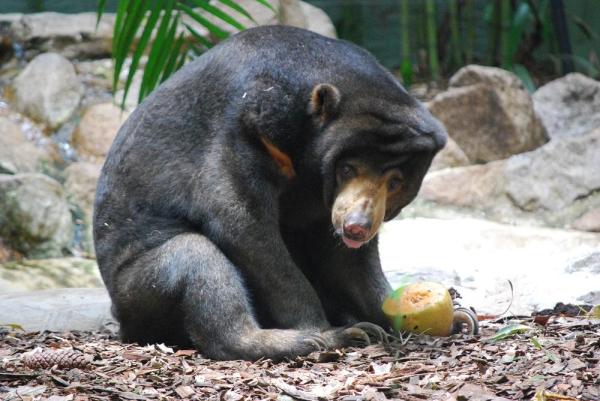
Sloth bear
Not a species cross between a bear and a sloth, the sloth bear (Melursus ursinus) lives in India, Sri Lanka and Nepal. They previously lived in Bangladesh, but they have since become extinct in this region. The climate of their habitats varies as they can thrive in humid tropical forests, dry savannas, scrub land and pastures. They try to avoid areas which are being disturbed by human beings.
They are characterized by having long, smooth and black hair which is quite different from other bear species. They have a prominent snout with long lips which can reach over their nose. This feature is the reason they are sometimes known as the ‘labiated bear’. They can weigh up to 180 kilograms and have a white V-shaped marking on their chest.
Their diet is halfway between insectivorous (insect based diet) and frugivorous (fruit based diet). Insects such as termites and ants can account for up to 80% of their diet. However, this will depend on the season. Once fruit is an option for the sloth bear, they can consume it for 70 to 90% of their food intake.
Sloth bears reproduce between May and July, the females giving birth to one or two cubs in the months of November and January. During the first nine months of their lives, the cub will be transported on their mother's back, but they will stay together for up to two and a half years.
Sloth bears have long sharp claws which can inflict serious damage. While they will not hunt tigers, they will charge in defence and have been know to inflict serious damage. They can be frightened easily and, for this reason, they have been known to kill humans. In fact, they are the species of bear which is most likely to attack humans. They likely see humans as predators and attack for this reason, not for food.

Spectacled bear
Similar to its cousin the panda, the spectacled bear (Tremarctos ornatus) is so-called due to its white markings on its mostly black fur. These markings leave two black spots around the bear's eyes to make it look as it if had sunglasses. The white markings extend to parts of its snout and neck. The rest of its fur is black which is finer than most other bear species, in part due to the hot climates of their habitat. This habitat can be found in South America, specifically Venezuela, Colombia, Ecuador, Bolivia and Peru.
They live in a wide variety of ecosystems throughout the tropical Andes. Dry tropical forests, tropical moist lowlands, mountainous forests and humid tropical shrubland. They can also live at high altitudes just as easily.
Like most bears, the spectacled bear is omnivorous. Their diet is based on very fibrous and rough vegetation such as tress branches, palm leaves and bromeliad plants. They can also feed on smaller mammals such as rabbits or mountain tapirs, but they tend to eat fowl mostly. When the fruit season comes, they will happily supplement their diet with a variety of tropical fruits.
Not much is known about the reproduction of this animal in the wild. In captivity, females have their estrous cycle throughout the year. The size of their litter varies between 1 and 4 cubs, although it is most common to have a litter of 2.

Grizzly
The brown bear (Ursus arctos) is distributed throughout much of the northern hemisphere. This includes Europe, Asia and the western part of the United States and Canada. Being a species with such a wide distribution, many of the populations are considered subspecies, there being about 12 different extant variants.
An example is the Kodiak bear (Ursus arctos middendorffi) that inhabits the Kodiak archipelago in Alaska. While we may not think of bears being present in mainland Europe, there are some small populations of Eurasian brown bear (Ursus arctos arctos) in Northern Spain and parts of Italy. The majority, however, appear further north in Russia and parts of Scandinavia.
Brown bears are not only brown, but can be black or cream. Their size varies according to the subspecies, but can be anywhere between 150 and 550 kg. In the upper weight range, we can find the Kodiak bear and the Eurasian bear is usually lighter, although this will depend on location.
Distribution also affects their diet. The famous grizzly bear is actually a type of brown bear found in North America, technically a North American brown bear (Ursus arctos ssp.). There are further subspecies of the North American bear, generally described by their habitat. One example is the now extinct California brown bear which can be seen on the state flag. The further north the bear population, the more carnivorous the bear. They are particularly known for eating salmon in the springtime, catching the fish as it rise from the water to swim up stream.
Their reproduction takes place between the months of April and July, but the fertilized ovum is not implanted in the uterus until autumn. Their cubs are born in January or February when the mother is hibernating and the litter will number between 1 and 3. The cubs stay with the mother for between 2 and 4 years. Brown bears are very protective of their young and have been known to maul humans who have crossed their path as they may fear for their safety.

Asian black bear
The population of the Asian black bear (Ursus thibetanus) is in recession. This animal inhabits the south of Iran, the mountainous regions of the north of Pakistan and Afghanistan, the south side of the Himalayas through India, Nepal and Bhutan and the continental Southeast Asia, extending towards the south in Myanmar and Thailand.
They are black with a small white spot shaped like a half moon on their chest. The skin around the neck is thicker than in the rest of the body. For most Asian black bears, their fur is thicker around this part also, giving them a ‘ruff’ look. They have a very distinctive white V-shaped marking on their chest, but the rest of their fur is black. There are also many subspecies of Asian black bear, the largest of which is the Ussuri black bear (Ursus thibetanus ussuricus) or the Manchurian black bear.
Physically, they are longer and thinner looking than their brown bear cousins. They have relatively strong front legs, unlike some other species of bear. They live in various types of forests, both in broad leaf and coniferous tree forests. This habitat can be at sea level or more than 4,000 meters above it.
Asian black bears have a varied and seasonal diet. In the springtime, they feed on shoots, leaves and branches. In summer they eat a large variety of insects such as ants and bees. They spend a lot of their time searching for these insects, sometimes as much as 7 or 8 hours a day. In autumn, their preference changes to acorns, nuts and chestnuts. They can also feed on ungulate animals and livestock when the option is available.
Unfortunately, the Asian black bear has a long history connected to traditional Chinese medicine. Their bile is collected for use in these medicines, harvested using catheters or other surgical methods. They are captured using steel traps which are known to sever limbs and are kept in cages where they have no space to move around. Often their teeth are broken off from biting their cage and they are regularly drugged to harvest the bile. It is a cruel and unnecessary practice. Although legislation has been brought to regulate the industry or even phase it out, many bear bile farms still exist. Illegal farms also still operate.
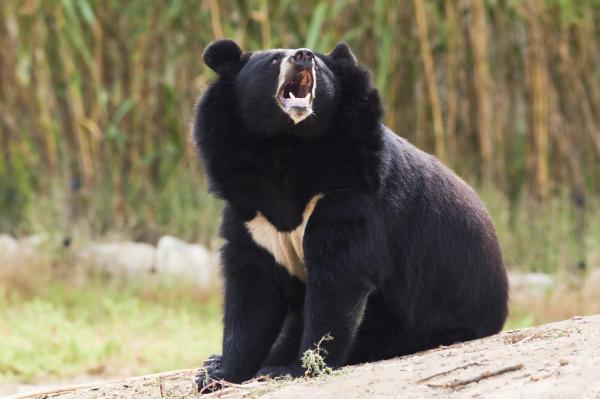
American black bear
The American black bear (Ursus americanus) has become extinct in most of the United States and Mexico, currently only inhabiting parts of Canada and Alaska. Fortunately, in these areas, the population is on the rise. It mainly lives in temperate and boreal (taiga) forests, but also extends to subtropical areas of Florida and Mexico. They can live close to sea level or more than 3,500 meters above it.
Despite its name, the American black bear can have variations of color in its coat. They can be a little more brown and some of them have a white patch similar to the Asian black bear, although not as many. They can weight between 40 and 250 kg with a much more robust build than most other bear species. They also have a particularly large head.
They are omnivorous, but also quite opportunist, eating whatever they find which appeals. They will eat whatever is available according to the season. This may include herbs, leaves, stems, seeds, fruit, livestock, wild mammals or bird eggs. They may even eat garbage if they come across it. In the fall, American black bears used to eat chestnuts. However, after a plague during the 20th century which severely cut down chestnut tree populations. This led to the bear moving on to acorns and other nuts. Their breeding season begins in late spring, but the cubs will not be born until the mothers hibernate.
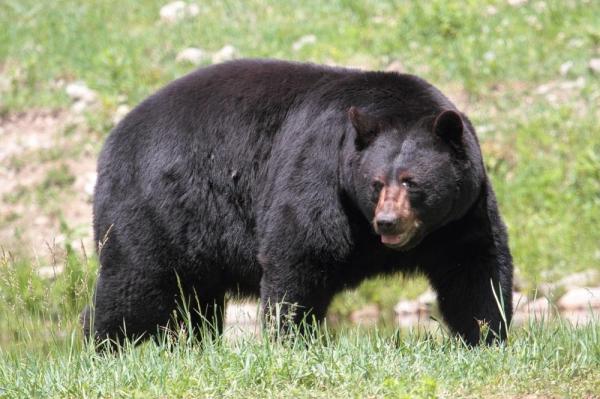
Giant panda bear
In the past, panda bear (Ailuropoda melanoleuca ) populations were widespread throughout China , but have now been relegated to the western end of the provinces of Sichuan, Shaanxi and Gansu. Thanks to the efforts invested in their conservation, it seems that this species is again growing, so the giant panda is no longer in danger of extinction. This doesn't mean they aren't still under threat, but that great stride have been made to bring population numbers back.
The panda is the bear most different to other bear species. The reason for this is believed to be that they were isolated from other bear populations for more than three million years, leading them to evolve differently. This means their divergence in appearance is normal. They have a round head with white fur, except for their ears and eyes which give them their famous expression. Their back and belly is also white, with their legs covered in thick black fur.
The panda bear's habitat is generally at higher altitudes, between about 1,200 and 3,300 meters above sea level. These areas tend to be temperate mountainous forests in China. Bamboo abounds in these forests and it has become their main food source. For many, it is practically their only food source. This reliance on bamboo means they are often quite slow moving creatures. The bamboo takes a long time to digest, so they can be quite sedentary.
The conservation of the panda has led them to becoming synonymous with species protection. They are the emblem for the World Wildlife Fund and are thought of as being friendly and playful. However, they are still wild bears and have been known to attack humans if provoked.
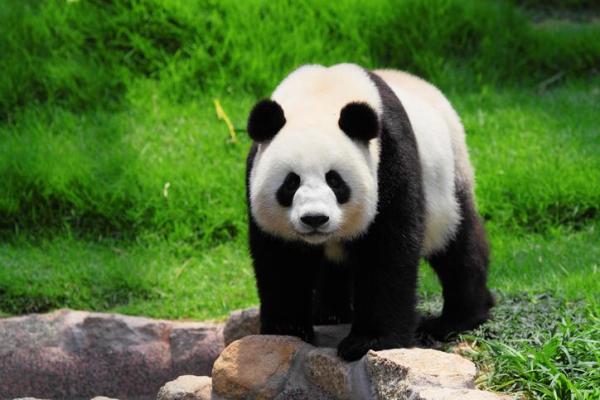
Polar Bear
The polar bear (Ursus maritimus) evolved from the brown bear 35 million years ago. This animal lives in the Arctic regions and its body is totally adapted to the frozen climate.
Their fur is actually hollow which gives it a translucent appearance. As the hair is full of air, it provides excellent insulation against the cold tundra it inhabits. Although the fur is transparent, it give the impression of looking white. This works well for their need to camouflage in the ice and snow. It is also the reason they are sometimes known as the white bear. Although difficult to see under their abundance of fur, the polar bear's skin is actually black: This helps them to both absorb and retain the sun's heat.
While many people associate the polar bear with gentleness, it is actually one of the most carnivorous bear species. Their diet is based on several seal species, such as the ringed seal (Phoca hispida) or the bearded seal (Erignathus barbatus). The results of climate change has meant sea temperatures are rising and melting the polar ice caps. This males it much more difficult for the polar bear to find food. The result is polar bears moving closer to human communities to find food and also dwindling populations.
Polar bears are the bear which breeds the least. They have their first cubs at the relatively old age of between 5 and 8 years. They usually give birth to 2 young and will stay with their mother for about 2 years. After this time, they return to a solitary life until mating occurs again.
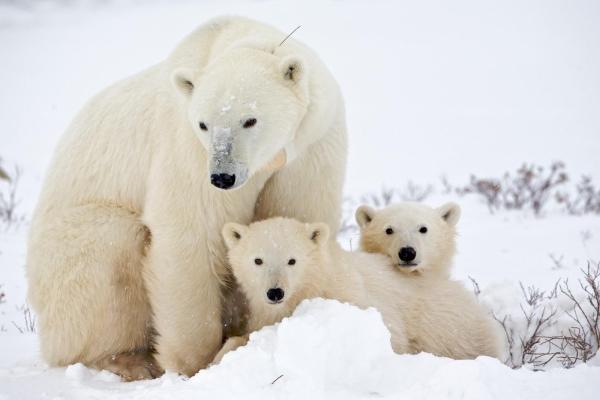
If you want to read similar articles to How Many Types of Bears Are There?, we recommend you visit our Facts about the animal kingdom category.
- Dharaiya, N., Bargali, HS & Sharp, T. 2016. Melursus ursinus. The IUCN Red List of Threatened Species 2016: e.T13143A45033815. Available at: https://www.iucnredlist.org/species/13143/45033815
- Garshelis, D. & Steinmetz, R. 2016. Ursus thibetanus (errata version published in 2017). The IUCN Red List of Threatened Species 2016: e.T22824A114252336. Available at: https://www.iucnredlist.org/species/22824/114252336
- Garshelis, DL, Scheick, BK, Doan-Crider, DL, Beecham, JJ and Obbard, ME 2016. Ursus americanus (errata version published in 2017). The Red List of Threatened Species of the IUCN 2016: e.T41687A114251609. Available at: https://www.iucnredlist.org/species/41687/114251609
- McLellan, BN, Proctor, MF, Huber, D. & Michel, S. 2017. Ursus arctos (amended version of 2017 assessment). The IUCN Red List of Threatened Species 2017: e.T41688A121229971. Available at: https://www.iucnredlist.org/species/41688/121229971
- Scotson, L., Fredriksson, G., Augeri, D., Cheah, C., Ngoprasert, D. & Wai-Ming, W. 2017. Helarctos malayanus (errata version published in 2018). The IUCN Red List of Threatened Species 2017: e.T9760A123798233. Available at: https://www.iucnredlist.org/species/9760/123798233
- Swaisgood, R., Wang, D. & Wei, F. 2016. Ailuropoda melanoleuca (errata version published in 2017). The IUCN Red List of Th